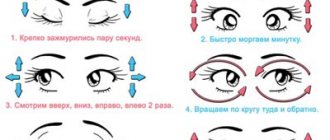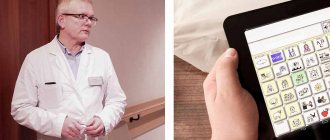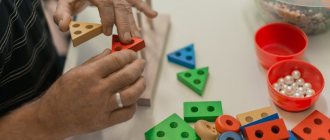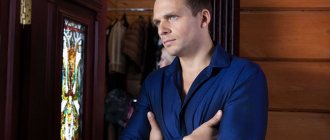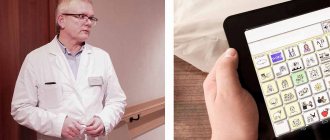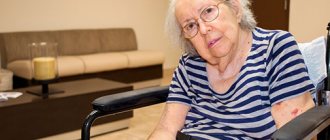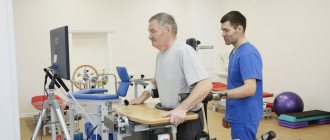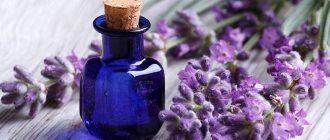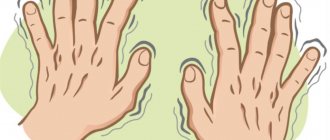Cognitive processes
There are three types of cognitive impairment after a stroke:
- Damage to one of the cognitive functions: memory (amnesia), the ability to perform any actions (apraxia), impairment of visual, auditory, tactile perception (agnosia).
- Violation of several functions that generally do not affect social adaptation.
- Multiple injuries that lead to social maladaptation: impaired attention, memory, volitional processes. In this case, post-stroke dementia is diagnosed. In older people with dementia, household activity decreases and self-care skills are lost. This category of patients is at risk of recurrent stroke.
The first and second variants of the disorder can be corrected due to the plasticity of the brain: damaged functions are compensated by functions that remain intact.
Rehabilitation of older people with post-stroke dementia includes sessions with psychologists. With the help of special exercises, patients develop auditory and visual memory, the ability to concentrate, and solve logical problems. The recovery process is accompanied by drug therapy.
General rules of care
The recovery period after a stroke is divided into early (up to 6 months), late (6-12 months) and residual effects (after 1 year). Ideally, in the early recovery period, the patient is recommended to be treated in palliative hospitals, sanatoriums, in the late recovery period and during the period of residual effects - in a day hospital, rehabilitation department, or by a visiting team at home. In reality, most often patients are at home after an acute period of stroke, and the main question that arises among their loved ones is where to begin rehabilitation. One of the main tasks of the rehabilitation process is to create comfortable conditions that promote relief and speedy recovery.
Preparing the premises
To exclude the impact of external traumatic factors (light, sound, temperature stimuli) on the patient’s psyche, he should be placed in a bright, well-ventilated room, where no extraneous noise can be heard from the street. The room should maintain a comfortable temperature within +18-22 °C.
The room should not be cluttered with furniture or objects that are easily moved out of place. A good alternative to a regular bed would be a functional one - with adjustable height and backrest position, side rails, and lockable wheels. Near the bed you need to place a bedside table with hygiene items, a blood pressure monitor, other necessary things, a wheelchair or other mobility aids (walkers, canes), a portable toilet or a bedpan.
If the person caring for the patient is not always with him, you can equip the room with a call button that the patient can easily reach, or replace it with a regular bell. Patients who can move independently or are beginning to train the skill of walking will find handrails along the walls very useful, and anti-slip mats in the bathroom will prevent injuries.
Body hygiene and bedsore prevention
Adequate prevention of bedsores can prevent their occurrence in 80% of cases.
Preventive measures:
- a special anti-bedsore or foam mattress with a thickness of at least 10 cm;
- soft bed linen without wrinkles;
- special cushions or pads made of foam rubber for vulnerable parts of the body (back of the head, shoulder blades, elbows, sacrum, heels, ankles);
- changing body position every 2-3 hours;
- comfortable underwear;
- prevention of skin trauma - carefully moving or turning over the patient.
It is important to carry out proper hygiene measures and skin care. At least once a day, during hygienic procedures, you should examine the entire surface of the patient’s body, vulnerable areas - every time you turn over. You should use waterproof diapers and diapers and change them as needed. It is necessary to wash the patient with warm water without soap after each bowel movement, washing with soap - no more than once a day, it is better to use liquid soap. After washing, the skin is thoroughly dried with a soft towel. For dry skin, moisturizing and nourishing creams are used; for diaper rash, powders without talc are used.
Nutrition
Food should be comfortable to swallow and easily digestible. The patient needs a sufficient amount of fluid - at least 1.5 liters. in the absence of restrictions. Drinking should not be limited even with urinary incontinence, since with a lack of fluid, urine becomes concentrated and irritates the skin.
The patient's diet should contain a sufficient amount of protein. It can be a soufflé, minced chicken, beef, rabbit, or fish. Patients who have difficulty chewing or swallowing semi-solid foods may be given meat or fish broth.
The menu should include dishes rich in vitamin C, iron, zinc, fermented milk products, fruits and vegetables.
Food is prepared boiled or baked and must be freshly prepared. You should not eat fried foods, pickles, smoked foods, spicy foods, canned food, fast food, carbonated and sweet drinks. You need to eat 4-5 times a day, in small portions.
Motor rehabilitation
The return of motor skills should begin as early as possible. Various exercises are used for rehabilitation after a stroke at home. Some of them can be done while the patient is in a supine position. These include:
- raising and lowering, bending and straightening the joints of the legs and arms;
- rotation of the arms at the wrist and elbow joints;
- clenching and unclenching fists;
- foot movements.
If the patient cannot yet sit or roll over independently, it is necessary to periodically change the position of his body.
An assistant helps the patient turn over by approaching him from the affected side and holding him by the healthy shoulder, knee or hip. When the patient begins to sit down, a special device on the functional bed will help him with this, by which he will pull himself up. You can do the following exercises while sitting:
- throwing the head back, tilting the head, rotating;
- stretching and bending the body forward;
- arching in the back, retraction of the shoulder blades;
- rotation of the arms in the shoulder joints;
- alternate leg lifts.
If a person can stand, the list of recommended exercises expands - the patient can additionally perform rotations and arm swings, bending, arm extensions with an expander, and walking in place.
Sitting down, changing positions in bed, getting up and walking if the patient was initially in a supine position is possible only after the doctor’s permission.
To improve coordination of movements, you should move your eyes in different directions, throw small objects at the target, gradually increasing their volume and mass and moving the target away. As the patient's condition improves, swinging movements in large joints, turns and tilts of the body are added.
Puzzles, construction sets, modeling from plasticine, origami, making appliques or regular copybooks are perfect for training fine motor skills.
Why is memory impaired after a stroke?
The moment when a vessel in the brain becomes clogged or ruptures, a person may not notice, because... there may be no consequences of circulatory disorders. However, in situations where the circulatory system is significantly damaged and the blood does not deliver oxygen to one or another part of the brain, its cells stop functioning with proper efficiency and gradually die.
Cell necrosis is the main reason why various complications occur after a stroke: paralysis, speech dysfunction, memory loss.
Timely medical care and intensive rehabilitation sessions provide a chance to eliminate the negative consequences. Cells in a healthy area can take over the functions of those affected.
Scientists, based on cutting-edge brain research, view human memory in the light of three integral components that are involved in its formation and functioning:
- Short-term. The ability to store material in a short time period and small volume - about 20 seconds and several elements.
- Long-term. Unlimited in time and volume. Provides long-term storage of information.
- Operational. The ability to hold any amount of information and perform various operations with it in a short period of time.
Recording, storing and reproducing information is one of the main functions that makes a person capable and ensures his normal functioning. Each new source contributes to the formation of new neural connections. In a situation where a person needs to use the knowledge he has ever acquired, the neural connection is activated.
However, after a cerebrovascular accident, countless neurons die, and the connections that were formed between them are destroyed. This is how the process of memory loss occurs. Together with the killed neurons, a lot of material that a person has managed to accumulate during his life goes away.
The nature of the disorders depends on which area was destroyed and in which hemisphere of the brain critical changes occurred. The hemispheres work together, exchanging millions of impulses with each other every second. Their normal operation is impossible without the use of memory mechanisms. Therefore, it is very difficult to specify and accurately state what changes will be entailed by the death of one or another part of memory, and how this will affect a person.
In any situation, a patient with a stroke requires immediate medical attention and a long recovery process.
Restoring everyday skills
All everyday skills should be developed under the supervision of a loved one, an assistant who will control the patient’s movements and, if necessary, support and guide his hand.
Nutrition
To prevent spoons and forks from slipping out of the patient’s hand, you can wrap their handles with thin foam rubber. If paralysis/paresis affects the leading hand, then when eating, you should help the patient - support and guide his hand towards the mouth.
Using the tap and washing your face
A chair should be placed in front of the sink so that the patient can wash while sitting. He should open the tap with the affected hand and, if necessary, should be assisted by guiding his hand towards the tap. In this case, the patient should check the temperature of the water with a healthy hand with preserved sensitivity. Once a comfortable temperature has been established, the patient should attempt to wash the affected hand.
Combing
You should choose combs made from non-slip materials, or wrap the comb handle with thin foam rubber. If possible, you should try to comb your hair with the hand with impaired function.
Dressing
Clothes (jacket, shirt) should be loose, fastened with buttons. It is placed on the knees, between which the sleeve for the affected arm is lightly fixed. With the help of the healthy one, she gradually moves into the sleeve.
Causes of brain stroke on the right
{banner_banstat0}
A right-sided stroke is different from a left-sided cerebral blood flow disorder because the functions of the two hemispheres are different. In the right - the centers that are responsible for sensitivity, motor skills, coordination are localized; with the help of the right hemisphere, a person understands words, uses hearing, touch, intuition, evaluates the surrounding space, perceives music, reads, writes, recognizes geometric shapes. In addition, the entire left side of the body is monitored and the information is analyzed together with data from the left hemisphere to completely solve any problem.
During a stroke, any of the listed functions are disrupted, and the trigger can be either an endogenous or an exogenous factor. The most dangerous:
- alcoholism, smoking, drugs;
- blood pressure surges, high ICP;
- binge eating;
- obesity;
- atherosclerosis;
- increased blood clotting;
- stress, psycho-emotional and physical stress;
- brain injuries;
- congenital pathologies;
- chronic somatic diseases of the heart and blood vessels;
- uncontrolled use of contraceptives.
Children with heart defects, genetic blood diseases, and endocrine disorders are at particular risk for right-sided stroke.
Speech rehabilitation
To restore speech skills, the patient will need to consult a speech therapist, who will prescribe exercises for training facial muscles, language, as well as help and certain behavior from loved ones.
The patient's relatives should constantly communicate with him, while pronouncing words slowly and clearly, avoiding complex long sentences. The patient must first train the pronunciation of individual sounds, gradually moving on to syllables and words. Sometimes it is easier for a person to pronounce words in a sing-song manner than in the usual way.
Recommended exercises:
- stretch out your lips like a tube and “bar your teeth”;
- lick and lightly bite lips;
- stick your tongue out of your mouth, stroke your cheeks with your tongue, “click” your tongue;
- puff out one's cheeks;
- smile, trying to use both sides of the mouth symmetrically.
Memory training
Memory and intellectual function training occurs simultaneously with speech restoration. The patient should try to repeat the syllables, words, phrases spoken by the assistant, gradually increasing the interval between pronouncing the word and repetition.
Board games, composing stories based on pictures, solving crossword puzzles, and even simple conversations help restore thinking abilities. Near each item in the room you can put a card with its name. As cognitive functions are restored, the patient can read, watch films, and discuss their content.
Psychological support
The patient’s relatives need to provide a positive environment at home, demonstrate their willingness to help, support the patient, and assure that his condition is temporary and changes for the better are inevitable. If the patient’s condition allows, he should be involved in feasible household chores, making him feel important and not removed from everyday worries.
A psychologist or psychotherapist will help you cope with panic attacks and depression. If the patient experiences acute conditions, aggression, or suicidal thoughts, the help of a psychiatrist and the prescription of medications may be required.
The duration of the recovery period depends on many factors: the extent of the damage, the age of the patient, and the presence of concomitant diseases. In patients who have suffered a mild form of stroke, partial recovery requires 1-2 months, and complete recovery takes about 3 months. In severe forms with persistent impairments, partial restoration of lost functions occurs after at least six months, and the chance of returning all lost skills is minimal.
According to statistics, after the first year after a stroke, 60% of patients do not need outside help. 30% can return to their previous work. Help with complex tasks is required during this period by 20% of patients. 15% of those who have suffered a stroke remain dependent on outside help, 5% need constant care.
Kinds
The consequences of a stroke are several types of amnesia. Based on what type of injury the attending physician diagnoses, individual treatment and rehabilitation measures are prescribed.
Types of amnesia:
- Damage to verbal memory;
- Visual glitches;
- Motor skills disorders;
- Damage to emotional-figurative memory.
- Vascular dementia.
Verbal
Verbal memory is the ability to remember, retain and reproduce verbal information.
If the part of the brain responsible for storing information received verbally is damaged, then the patient cannot remember the names of relatives and friends, forgets the names of objects, and loses vocabulary. Communication with others becomes extremely difficult, and the victim has difficulty remembering new information.
Visual memory impairment
A person’s ability to fix, store and use various information that is received in the form of a visual image is called visual memory.
After a stroke, a patient whose area that stores visual information is damaged may not recognize everything around him: his home, family, friends, objects, etc.
Loss of motor skills
Motor skills are a person’s ability to confidently perform complex movements. Patients forget the simplest actions: how to use cutlery, walk, squat, write, grasp objects with their hands, go up and down stairs, etc.
Loss of emotional-figurative memory
Emotional-visual memory is responsible for the ability to record and store feelings and emotions that are associated with any object, person, event or phenomenon. If it is violated, the patient ceases to recognize the images and emotions that are associated with them. He does not remember the taste of dishes that he previously considered favorite, changes his musical tastes, and does not recognize the voices of loved ones and acquaintances.
Vascular dementia
The most complex type of brain disorder, which is difficult to recover, is vascular dementia. The adequacy of a person’s perception of what surrounds him disappears almost completely over time.
A person does not recognize objects that he used to constantly use, does not remember their names and purposes. When communicating with other people, the patient cannot remember their names and where he knows them from. This applies not only to distant acquaintances or strangers, but also to close relatives, friends and colleagues.
However, if you choose the right intensive rehabilitation measures and constantly monitor the patient’s condition, you can slow down the process of dementia and adapt the person to real life.
